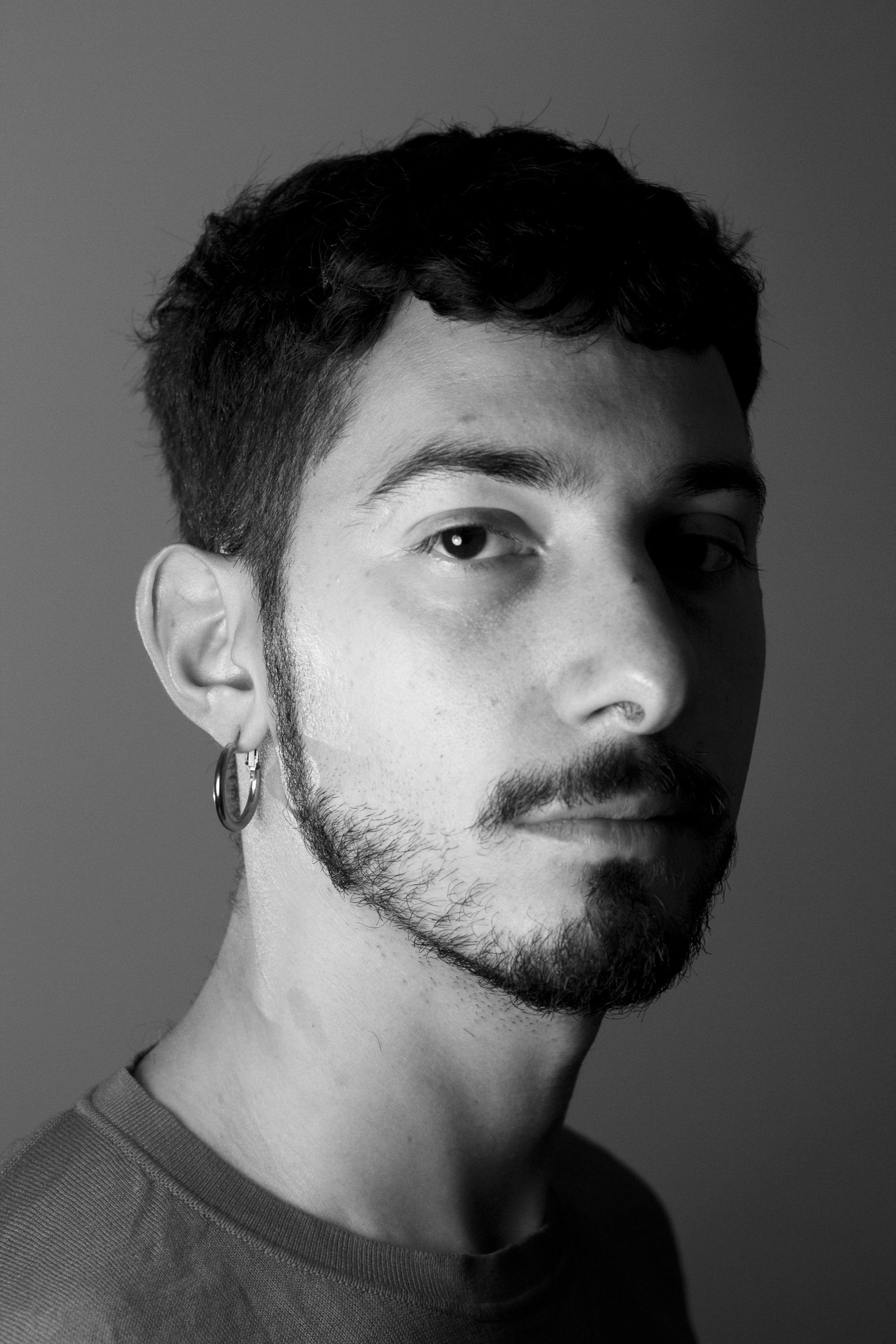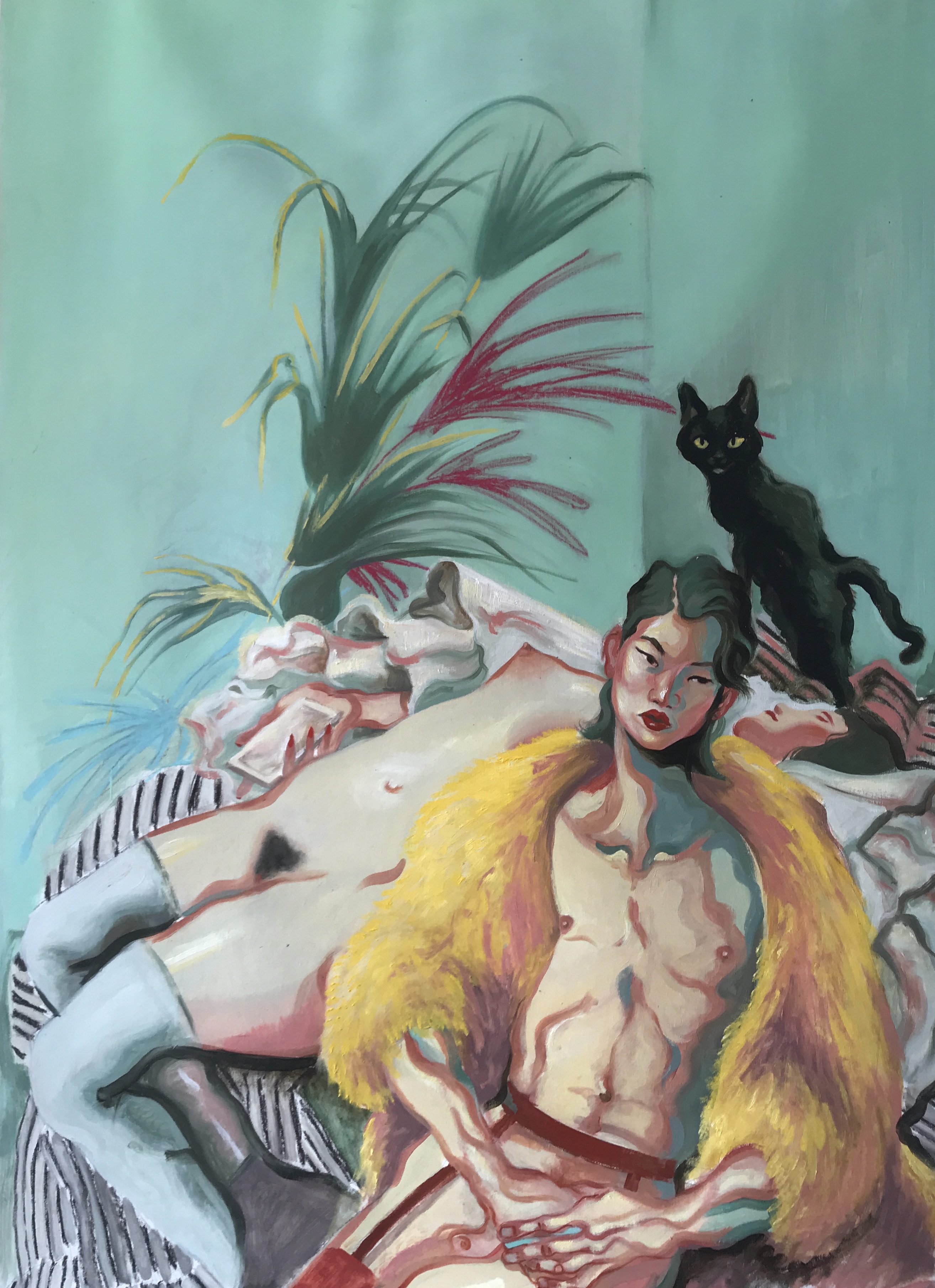
First crossed paths with Barcelona-based painter Giorgio Celin at the group show “Mistici, Sensuali, Contemplativi” curated by Nicola Nitido at artist-run space Metodo Milano in September 2020. Celin’s alchemical and intimate paintings immediately enticed me and made me reflect on feelings of loss, nostalgia, queer desire, and loneliness in this capitalist, fast-paced society. In this interview for “Spectrum: Fluid Narratives”, we discussed the process of storytelling in his artworks and how fluidity encompasses both the process of painting and the subjects on the canvas. Fluid are the characters, the colours, the brushstrokes, the time, the space, everything is left intentionally open to interpretation and kind of mysterious.
Francesco Ferranti: Can you please introduce yourself?
Giorgio Celin: Hey, I’m Giorgio Celin and I am a painter based in Barcelona, Spain. My Pronouns are He-Him. I was born in Barranquilla, Colombia.
Francesco Ferranti: What does painting mean to you?
Giorgio Celin: I think painting as poetry, a mystery, an alchemical process : explaining it too much would be like killing “the feeling” of it.
A successful painting is one that can give the viewer, through a particular composition, set of lines or a certain use of color, the recreation of a feeling.
I like to frame my work in a relative conceptual mystery : I want to avoid intellectual speculation and encourage the engagement of the viewer in the construction of the narrative of the art work. This process creates a “living entity” not a dead, over-criticized, over-intellectualized “museum piece”.
Francesco Ferranti: How does queerness and your experience of the latinx diaspora intersect in your art?
Note of the editor: The word “Latinx” originated in the mid-2000s “in activist circles primarily in the U.S. as an expansion of earlier gender-inclusive variations such as Latino/a (with the slash) and Latin@ (with the “at” sign),” says Joseph. M. Pierce @pepepierce, an associate professor in the Department of Hispanic Languages and Literature at Stony Brook University.
Giorgio Celin: A process of queerization is very important and one of the basic topics of my art : coming from a conservative country, and as a queer individual, a latinx that experienced the process of migrating from one country to the other multiple times , I feel the urgency to use queerness as a political tool to push the visual conversation forward and fight visual stereotypes of both heteronormative and mainstream gay imagery.
Queerization doesn’t apply only to sexuality, but also to the subject matter : the latin-american diaspora is very underrepresented in the history of visual art. The latinx diaspora is a very complex phenomenon, both visually and conceptually, it does not exist within a monolith, but contains multitudes. Through immersion in this particular experience, I want to create new narratives and build a visual universe where the migrant experience is a beautiful and celebrated process, rather than an “exotic decoration”.
Francesco Ferranti: Which paintings have you selected for “SpectRoom: Fluid Narratives” and why?

Giorgio Celin: The title of the painting ‘Let’s follow the cops back home’ (2020) comes from a song by the band Placebo. The painting talks about this guy who is on medication and he came back from a show to his house with a friend. The scene is deliberately ambiguous. I wanted to live a space to the viewer to complete the story or imagine what is going on in the mind of the main character.
In my story he is reflecting on his gender identity and thinking about transitioning. But it doesn’t need to be clear, this is just one narrative of the many that you can’t apply to this picture.

The painting ‘Fantasmi Azzurri‘ (2020) is about memories. Those lonely times in which your own personal ghost come and visit you, haunting your house and your heart like in a ghost story. The figures are deliberately confusing on their gender appearance.
Francesco Ferranti: What does Spectrum mean to you?
Giorgio Celin: Spectrum to me means the possibility of being more fluid about one’s own gender identity and the possibility to move away from that constructed narrative of “pink-blue ideology”, like this sort of binary violence that has been pushed on us. And finally, the possibility to have a more fluid narrative and understanding of whatever society is, like what your gender is, what your work is, what your way of life is.
Francesco Ferranti: What are your hopes and dreams for the future?
Giorgio Celin: My hope is that this Covid nightmare ends soon! Moving around the world is for me a source of great inspiration. A formal need, a schizophrenic routine, a way to find beauty in this lonely and difficult experience that is living on this earth. My dream is to become one of the great painters from Latin America. The painter that celebrated his humble upbringing, the beautiful diversity of his people, a great of voice of the diaspora, and a very proud *maricon* (an originally pejorative slur used from some latinx people as a word of empowerment like queer) , in the greater sense of the word.
Francesco Ferranti: Are you currently working on any new projects or shows?
Giorgio Celin: I am working for the next show this summer in London. It’s going to be my first *physical* show there and I’m excited. Is a continuation of the themes of my latest project “Pajaros del Atlantico”.
I’m working on new series as well : I miss the bars, the strangers, las borracheras (getting drunk), the nightlife that is full of the worst and best humanity I’ve ever encountered in my life. I think I will work on that for a show later this year. I’m also doing research for some mythological paintings I want to do. Let’s see…
To know more about Giorgio Celin: @giorgiocelin / www.giorgiocelin.com
